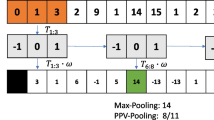Abstract
The aim of this work is to extend a previously presented algorithm (Durzinsky et al. 2008b in Computational methods in systems biology, LNCS, vol 5307. Springer, Heidelberg, pp 328–346; Marwan et al. 2008 in Math Methods Oper Res 67:117–132) for the reconstruction of standard place/transition Petri nets from time-series of experimental data sets. This previously reported method finds provably all networks capable to reproduce the experimental observations. In this paper we enhance this approach to generate extended Petri nets involving mechanisms formally corresponding to catalytic or inhibitory dependencies that mediate the involved reactions. The new algorithm delivers the set of all extended Petri nets being consistent with the time-series data used for reconstruction. It is illustrated using the phosphate regulatory network of enterobacteria as a case study.
Similar content being viewed by others
References
Durzinsky M, Marwan W, Wagler A, Weismantel R (2008a) Automatic reconstruction of molecular and genetic networks from experimental time series data. BioSystems 93: 181–190
Durzinsky M, Wagler A, Weismantel R (2008b) A combinatorial approach to reconstruct Petri nets from experimental data. In: Computational methods in systems biology, LNCS, vol 5307. Springer, Heidelberg, pp 328–346
Durzinsky M, Marwan W, Wagler A (2011a) Reconstruction of extended Petri nets from time series data and its application to signal transduction and to gene regulatory networks. BMC Syst Biol 5:113. doi:10.1186/1752-0509-5-113
Durzinsky M, Wagler A, Weismantel R (2011b) An algorithmic framework for network reconstruction. J Theor Comput Sci 412(26): 2800–2815
Heiner M, Koch I (2004) Petri net based model validation in systems biology. In: 25th International conference on application and theory of Petri nets. Springer, Heidelberg, pp 216–237
Hsieh YJ, Wanner BL (2010) Global regulation by the seven-component pi signaling system. Curr Opin Microbiol 13: 198–203
Kholodenko BN, Kiyatkin A, Bruggeman FJ, Sontag E, Westerhoff HV, Hoek JB (2002) Untangling the wires: a strategy to trace functional interactions in signaling and gene networks. Proc Natl Acad Sci USA 99(20): 12841–12846
Koch I, Heiner M (2008) Petri nets in biological network analysis. In: Junker BH, Schreiber F (eds) Analysis of biological networks. Wiley Book Series on Bioinformatics. Wiley, New York, pp 139–179
Krishna R, Guo S (2008) A partial granger causality approach to explode causal networks derived from multi-parameter data. In: Computational methods in systems biology, LNCS, vol 5307. Springer, Heidelberg, pp 9–27
Laubenbacher R, Stigler B (2005) A computational algebra approach to reverse engineering of gene regulatory networks. J Theor Biol 229: 523–537
Marbach D, Prill RJ, Schaffter T, Mattiussi C, Floreano D, Stolovitzky G (2010) Revealing strengths and weaknesses of methods for gene network inference. Proc Natl Acad Sci 107(14): 6286–6291
Marwan W, Wagler A, Weismantel R (2008) A mathematical approach to solve the network reconstruction problem. Math Methods Oper Res 67: 117–132
Marwan W, Rohr C, Heiner M (2010) Petri nets in Snoopy: a unifying framework for the graphical display, computational modelling, simulation, and bioinformatic annotation of bacterial regulatory network. In: Helden Jv, Toussaint A, Thieffry D (eds) Bacterial molecular networks, methods in molecular biology. Humana Press, USA (in press)
Marwan W, Wagler A, Weismantel R (2011) Petri nets as a framework for the reconstruction and analysis of signaling transduction pathways and regulatory networks. Nat Comput 10(2): 639–654
Matsuno H, Tanaka Y, Aoshima H, Doi A, Matsui M, Miyano S (2003) Biopathways representation and simulation on hybrid functional Petri net. In Silico Biol 3: 389–404
McCluskey EJ (1956) Minimization of boolean functions. Bell Syst Tech J 35: 1417–1444
Neidhardt FC, Ingraham JL, Schaechter M (1990) Physiology of the bacterial cell. A molecular approach. Sinauer Associates, Sunderland
Pinney JW, Westhead RD, McConkey GA (2003) Petri net representations in systems biology. Biochem Soc Trans 31: 1513–1515
Umans C (1998) The minimum equivalent DNF problem and shortest implicants. In: FOCS’98, pp 556–563
Wagler A, Weismantel R (2011) The combinatorics of modeling and analysing biological systems. Nat Comput 10(2): 655–681
Author information
Authors and Affiliations
Corresponding author
Rights and permissions
About this article
Cite this article
Durzinsky, M., Marwan, W. & Wagler, A. Reconstruction of extended Petri nets from time-series data by using logical control functions. J. Math. Biol. 66, 203–223 (2013). https://doi.org/10.1007/s00285-012-0511-3
Received:
Revised:
Published:
Issue Date:
DOI: https://doi.org/10.1007/s00285-012-0511-3




